Solid-State Microwave Power Module
communications
Solid-State Microwave Power Module (LEW-TOPS-70)
Single module provides highperformance radar, communications, and navigation
Overview
Innovators at NASA's Glenn Research Center have developed a microwave power module to power radar, communications, and/or navigation interchangeably. This high-efficiency, all-solid-state microwave power module (MPM) is based on a multi-stage distributed-amplifier design, which is capable of very wideband operation. This MPM is extremely durable and can last a decade or longer. Already more compact and lightweight than conventional designs, Glenn's patented technique offers further size reduction by eliminating the need for either a traveling-wave tube amplifier or its accompanying kV-class electronic power conditioner. The performance of this MPM is exceptional, with much higher cut-off frequency and maximum frequency of oscillation than metal-semiconductor-field-effect-transistors offer, and the distributed amplifier's wide bandwidth also results in much faster pulse rise times. Finally, Glenn's design allows the module to operate in both pulsed and continuous wave modes, so it can singlehandedly drive exceptional performance for radar, navigation, and communications.
The Technology
Typically, microwave power modules (MPMs) are useful only for radar and navigation purposes because they lack the linearity and efficiency required for communications. In standard configurations, conventional MPMs require both a solid-state amplifier at the front end and a microwave vacuum electronics amplifier at the back end. By contrast, Glenn's design features a wideband multi-stage distributed amplifier system. The low-power stage is a high-efficiency gallium arsenide (GaAs) pseudomorphic high-electron-mobility transistor (pHEMT)-based monolithic microwave integrated circuit (MMIC) distributed amplifier. The medium-power stage is configured to pick up and amplify the low-power signal. This stage can be either another high-efficiency GaAs pHEMT or a gallium nitride (GaN) HEMT-based MMIC distributed amplifier, depending on the need. The high-power stage, configured to pick up the signal from the second amplifier, is a high-efficiency GaN HEMT-based MMIC distributed amplifier, which supplants the traveling-wave tube amplifier found in most microwave power modules.
In Glenn's novel MPM, the radar functions as a scatterometer, radiometer, and synthetic aperture imager. The high-speed communications system down-links science data acquired by Earth-observing instruments. The navigation system functions like a transponder for autonomous rendezvous and docking, and estimates the range information. Glenn's MPM gives systems the versatility to use a single power module to drive not only radar and navigation but also communications systems.


Benefits
- Wide bandwidth: Amplifies signals over the 2 to 20 GHz and 20 to 40 GHz radio frequency (RF) ranges
- High efficiency: Operates in both pulsed and continuous wave modes
- High output power: Enables reliable performance in high RF ranges
- Reduced payload: Comprises compact and lightweight all-solid-state materials
- Radiation resistance: Uses gallium nitride (GaN), a wide bandgap semiconductor, which is inherently radiation-hard
Applications
- Commercial and military satellite communications
- Military radar systems
- Phased-array antenna systems
- Aerospace (radar, communications, navigation)
|
Tags:
|
Similar Results

Microwave Power Combiner
MMICs are a type of integrated circuit that operates at microwave frequencies to amplify electronic signals. The system has at least two power amplifiers; input ports to receive power from the amplifiers; at least one power combiner, which receives power from each input port and combines them to produce maximized power; an output port that sends this maximized power to its destination; and an isolated port, either grounded or match-terminated, that receives no or negligible power from the combiner. The output port can be connected to a load, and can employ more than one combiner, so that the power from another combiner and an input port can be combined, for example, in a 3-way unequal power combiner.
Glenn's Ka-band demonstration power combiner has an output return loss better than 20 dB, and a high degree of isolation between the output port and the isolated port, as well as between the two input ports. When the ratio of output power for two MMICs is two-to-one, the combined efficiency is better than 90%. However, the design is not limited to a two-to-one ratio; it can be customized to any arbitrary power output ratio. This means that a low-power gallium arsenide MMIC can be combined with a high-power gallium nitride MMIC, giving designers much more flexibility. The output impedance of the MMIC power amplifier is matched directly to the waveguide impedance, without first transitioning into a transmission line. This technique eliminates the losses associated with a transition and enhances the overall efficiency. Furthermore, the MMIC power combiner is dual purpose- run in reverse it serves as a power divider. To reduce the cost and weight the combiner can be manufactured using 3-D printing and metal-plated plastic. By combining MMIC amplifiers more efficiently, Glenn's technology greatly enhances communications from near-Earth and deep space-to-Earth.

Multimode Directional Coupler
Glenn's researchers originally created the MDC to improve the beacon sources for atmospheric propagation studies. These studies are typically conducted to test atmospheric conditions to determine the signal strength needed for satellite communications. A low-power transmitter (e.g., a beacon source) is attached to the satellite, and transmits a continuous waveform (CW) signal to a receiving station on Earth. However, when a separate frequency is desired, building a new beacon source for the transmitter on the satellite - especially one that will operate at higher frequencies - presents numerous challenges. For one, a single-frequency beacon source requires a temperature-stabilized oscillator for frequency generation separate from that provided by the spacecraft receiver.
To solve such problems, Glenn's innovators fabricated the MDC from two sections of waveguide: a primary waveguide for the fundamental frequency (Ku-band), and a secondary waveguide for the harmonics (Ka-band). These sections are joined together so that precision-machined slots in the second waveguide selectively couple the harmonics, for amplification and transmission. The harmonics can then be used as an additional beacon source with very small power losses to the fundamental signal. Once the separation takes place, the second or higher harmonic can be amplified and transmitted to a station on Earth. The efficiency and performance of the MDC can be optimized through appropriate computer modeling software and currently available high-precision fabrication techniques. Without the complexity and expense involved in building separate traveling wave tube amplifiers to generate additional frequencies, Glenn's MDC enables satellites to produce multiple signals that can be received by multiple stations - a significant leap forward in satellite productivity.

High-Voltage Power System for Hybrid Electric Aircraft Propulsion
Glenn's novel system supports the NASA Aeronautics Research Mission Directorate (ARMD) strategic plan to leverage advancements in technologies over the next 25 years and beyond, leading to new aircraft configurations with enhanced performance, improved energy efficiency, and reduced CO2 emissions. The electric system is a multi-megawatt micro-grid that converts mechanical energy to electric via generators, and electric energy to mechanical via motor-driven fans. This innovation would use the variation in aircraft throttle settings to produce a high-voltage (20 kilovolts), variable-frequency 9-phase AC distribution system. Using doubly fed electric machines (generator, propulsor, and flywheel) allows for field excitation that can cause variable-frequency or variable speed operation around the commanded throttle setting. The flywheel enables an energy storage system that recovers and reuses energy, while the flywheel slews with the throttle control using the electromagnetic torque produced by the doubly fed electric machine. This design permits both sub-synchronous and super-synchronous operation using limited field excitation power provided through power converters. Finally, the reduced switchgear mass facilitated through the use of a high-frequency AC system, setting-less protection zones, and simplified switches for fault clearance provides enhanced operational capability. This system can be controlled so that fault energy is minimized, preventing collateral damage to aircraft structures even with high voltage distribution. Glenn's innovative system adds performance, efficiency, reliability, and cost savings to cutting-edge hybrid electric technology.
This is an early-stage technology requiring additional development, and Glenn welcomes co-development opportunities.

Optical Tunable-Based Transmitter for Multiple High-Frequency Bands
NASA Glenn's researchers have developed a means of transporting multiple radio frequency carriers through a common optical beam. In contrast to RF infrastructure systems alone, this type of hybrid RF/optical system can provide a very high data-capacity signal communication and significantly reduce power, volume, and complexity. Based on an optical wavelength division multiplexing (WDM) technique, in which optical wavelengths are generated by a tunable diode laser (TDL), the system enables multiple microwave bands to be combined and transmitted all in one unit. The WDM technique uses a different optical wavelength to carry each separate and independent high-frequency microwave band (e.g., L, C, X, Ku, Ka, Q, or higher bands). Since each RF carrier operates at a different optical wavelength, the tunable diode laser can, with the use of an electronic tunable laser controller unit, adjust the spacing wavelength and thereby minimize any crosstalk effect.
Glenn's novel design features a tunable laser, configured to generate multiple optical wavelengths, along with an optical transmitter. The optical transmitter modulates each of the optical wavelengths with a corresponding RF band and then encodes each of the modulated optical wavelengths onto a single laser beam. In this way, the system can transmit multiple radio frequency bands using a single laser beam. Glenn's groundbreaking concept can greatly improve the system flexibility and scalability - not to mention the cost of - both ground and space communications.

Tunable Multi-Tone, Multi-Band, High-Frequency Synthesizer
Glenn's revolutionary new multi-tone, high-frequency synthesizer can enable a major upgrade in the design of high data rate, wide-band satellite communications links, in addition to the study of atmospheric effects. Conventional single-frequency beacon transmitters have a major limitation: they must assume that atmospheric attenuation and group delay effects are constant at all frequencies across the band of interest. Glenn's synthesizer overcomes this limitation by enabling measurements to be made at multiple frequencies across the entire multi-GHz wide frequency, providing much more accurate and actionable readings.
This novel synthesizer consists of a solid-state frequency comb or harmonic generator that uses step-recovery semiconductor diodes to generate a broad range of evenly spaced harmonic frequencies, which are coherent and tunable over a wide frequency range. These harmonics are then filtered by a tunable bandpass filter and amplified to the necessary power level by a tunable millimeter-wave power amplifier. Next, the amplified signals are transmitted as beacon signals from a satellite to a ground receiving station. By measuring the relative signal strength and phase at ground sites the atmospheric induced effects can be determined, enabling scientists to gather essential climate data on hurricanes and climate change. In addition, the synthesizer can serve as a wideband source in place of a satellite transponder, making it easier to downlink high volumes of collected data to the scientific community. Glenn's synthesizer enables a beacon transmitter that, from the economical CubeSat platform, offers simultaneous, fast, and more accurate wideband transmission from space through the Earth's atmosphere than has ever been possible before.


